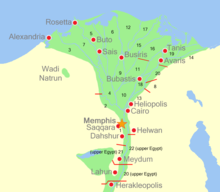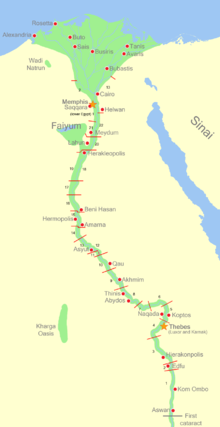- Nome (Egypt)
-
For other uses, see Nome.
A nome (from Greek: Νομός, “district”) was a subnational administrative division of ancient Egypt. Today's use of the Greek nome rather than the Egyptian term sepat came about during the Ptolemaic period. Fascinated with Egypt, Greeks created many historical records about the country. These were more accessible to later Western historians and influenced their adoption of Greek terms.
Contents
Ancient Egypt
The division of ancient Egypt into nomes can be traced back to the Predynastic Period (before 3100 BC). These nomes originally existed as autonomous city-states[citation needed], but later began to unify. According to ancient tradition, the ruler Menes completed the final unification.[1]
Not only did the division into nomes remain in place for more than three millennia, the areas of the individual nomes and their ordering remained remarkably stable. Some, like Xois in the Delta or Khent in Upper Egypt, were first mentioned on the Palermo stone, which was inscribed in the Fifth Dynasty. The names of a few, like the nome of Bubastis, appeared no earlier than the New Kingdom. Under the system that prevailed for most of pharaonic Egypt's history, the country was divided into 42 nomes.
Lower Egypt, from the Old Kingdom capital Memphis to the Mediterranean Sea, comprised 20 nomes. The first was based around Memphis, Saqqara, and Giza, in the area occupied by modern-day Cairo. The nomes were numbered in a more or less orderly fashion south to north through the Nile delta, first covering the territory on the west before continuing with the higher numbers to the east. Thus, Alexandria was in the Third Nome; Bubastis was in the Eighteenth.
Upper Egypt was divided into 22 nomes. The first of these was centered around Elephantine close to Egypt's border with Nubia at the First Cataract – the area of modern-day Aswan. From there the numbering progressed downriver in an orderly fashion along the narrow fertile strip of land that was the Nile valley. Waset (ancient Thebes or contemporary Luxor) was in the Fourth Nome, Amarna in the Fourteenth, and Meidum in the Twenty-first.
Ptolemaic and Roman Egypt
Some nomes were added or renamed during the Graeco-Roman occupation of Egypt. For example, the Ptolemies renamed the Crocodilopolitan nome to Arsinoe. Hadrian created a new nome, Antinoopolites, for which Antinoopolis was the capital.
The nomarch
At the head of each nome stood a nomarch. The position of the nomarch was at times hereditary, while at others they were appointed by the pharaoh. Generally, when the national government was stronger, nomarchs were the king's appointed governors. When the central government was weaker, however – such as during foreign invasions or civil wars – individual nomes would assert themselves and establish hereditary lines of succession. Conflicts between these different hereditary nomarchies were common during, for example, the First Intermediate Period – a time that saw a breakdown in central authority lasting from the sixth and eleventh dynasties, until one of the local rulers was once again able to assert control over the entire country as pharaoh.
Survival of the nomes
The nomes survived through the Ptolemaic period, into Roman times. Under Roman rule, individual nomes minted their own coinage, the so-called "nome coins," which still reflect individual local associations and traditions. The nomes of Egypt retained their primary importance as administrative units until the fundamental rearrangement of the bureaucracy during the reigns of Diocletian and Constantine.
From AD 307/8, their place was taken by smaller units called pagi. Eventually powerful local officials arose who were called pagarchs, through whom all patronage flowed. The pagarch's essential role was as an organizer of tax-collection. Later the pagarch assumed some military functions as well. The pagarchs were often wealthy landowners who reigned over the pagi from which they originated.
List of nomes
The nomes are listed in separate tables for Upper and Lower Egypt
Lower Egypt
Number Egyptian Name Capital Modern Capital Translation 1 Aneb-Hetch Ineb Hedj / Men-nefer / Menfe (Memphis) Mit Rahina White Walls 2 Khensu Khem (Letopolis) Ausim Cow's thigh 3 Ahment Imu (Apis) Kom el-Hisn West 4 Sapi-Res Ptkheka Tanta Southern shield 5 Sap-Meh Zau (Sais) Sa el-Hagar Northern shield 6 Khaset Khasu (Xois) Sakha Mountain bull 7 A-ment (Hermopolis Parva, Metelis) Damanhur West harpoon 8 A-bt Tjeku / Per-Atum (Heroonpolis, Pithom) Tell al-Maskhuta East harpoon 9 Ati Djed (Busiris) Abu Sir Bara Andjeti 10 Ka-khem Hut-hery-ib (Athribis) Banha (Tell Atrib) Black bull 11 Ka-heseb Taremu (Leontopolis) Tell al-Urydam Heseb bull 12 Theb-ka Tjebnutjer (Sebennytos) Samanud Calf and Cow 13 Heq-At Iunu (Heliopolis) Materiya (suburb of Cairo) Prospering Sceptre 14 Khent-abt Tjaru (Sile, Tanis) Tell Abu Sefa Eastmost 15 Tehut Ba'h / Weprehwy (Hermopolis Parva) Baqliya Ibis 16 Kha Djedet (Mendes) Tell al-Rubˁ Fish 17 Semabehdet Semabehdet (Diospolis Inferior) Tell el-Balamun The throne 18 Am-Khent Per-Bastet (Bubastis) Tell Bastah (near Zagazig) Prince of the South 19 Am-Pehu Dja'net (Leontopolis Tanis) Nebesha or San el-Hagar Prince of the North 20 Sopdu Per-Sopdu Saft al-Henna Plumed Falcon Upper Egypt
Number Egyptian Name Capital Modern Capital Translation 1 Ta-Seti Abu / Yebu (Elephantine) Aswan Land of the bow 2 Wetjes-Hor Djeba (Apollonopolis Magna) Edfu Throne of Horus 3 Ten Nekhen (Hierakonpolis) al-Kab Shrine 4 Waset Niwt-rst / Waset (Thebes) Karnak Sceptre 5 Herui Gebtu (Coptos) Qift The two falcons 6 Aa-ta Lunet / Tantere (Tentyra) Dendera The crocodile 7 Seshesh Seshesh (Diospolis Parva) Hu Sistrum 8 Abdju Abdju (Abydos) al-Birba Great land 9 Min Apu / Khen-min (Panopolis) Akhmim Min 10 Wadkhet Djew-qa (Aphroditopolis) Ifteh Cobra 11 Set Shashotep (Hypselis) Shutb The creature associated with Set 12 Tu-ph Hut-Sekhem-Senusret (Antaeopolis) Qaw al-Kebir Viper mountain 13 Atef-Khent Zawty (z3wj-tj, Lycopolis) Asyut Upper Sycamore and Viper 14 Atef-Pehu Qesy (Cusae) al-Qusiya Lower Sycamore and Viper 15 Un Khemenu (Hermopolis Magna) al-Ashmunayn Hare 16 Meh-Mahetch Hebenu Kom el Ahmar Oryx 17 Anpu Saka (Cynopolis) al-Kais Anubis 18 Sep Teudjoi / Hutnesut (Alabastronopolis) el-Hiba Set 19 Uab Per-Medjed (Oxyrhynchus) el-Bahnasa Two Sceptres 20 Atef-Khent Henen-nesut (Herakleopolis Magna) Ihnasiyyah al-Madinah Southern Sycamore 21 Atef-Pehu Shenakhen / Semenuhor (Crocodilopolis, Arsinoe) Madinat al-Fayyum Northern Sycamore 22 Maten Tepihu (Aphroditopolis) Atfih Knife Notes
- ^ Herodotus, Euterpe, 2.4.1 and 2.99.1ff.
References
- Alan K. Bowman (1990). Egypt After the Pharaohs. Oxford University Press.
External links
Categories:- Geography of ancient Egypt
- Nome of ancient Egypt
- Greco-Roman Egypt
Wikimedia Foundation. 2010.


